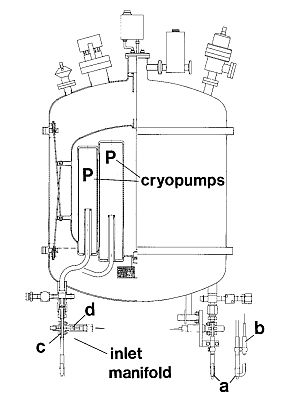Purpose of the flight and payload description
The objective of the flight was to collect large air samples using a balloon-borne cryogenic whole-air sampler, that was cooled with liquid neon. The mission was part of a field program started in 1982 by the Institut für Atmosphärische Chemie, Forschungszentrum Jülich (KFA) from Germany to measure in situ the vertical distribution of long-lived trace gases in the stratosphere. The program was the continuation of a series of flights performed between 1977 and 1979 in cooperation with other research institutes from Germany.
The sampler consisted of a dewar measuring 80 cm height and 60 cm of diameter in which 15 stainless steel containers were submerged in liquid neon and cooled to temperatures around 30º Kelvin. Five containers had a volume of 580 cm3 while the remaining ten had a capacity of 380 cm3 allowing a maximum collecting volume on each flight of 10 liters at standard temperature and pressure. Each container has its own cryopump, manifold and a device that was activated by telecommand during the course of the balloon flight where distinct samples were to be collected. A schematic view of the instrument is given in the figure at left. The cross-section (left part) shows the arrangement of the cryopumps (P) and the inlet manifolds located at the bottom; (a) breakable glass inlet (it maintains closed the inlets until reaching operative altitude), (b) spring loaded piston which break the glass sealing upon command from the ground; (c) gold tube and (d) squib fired closing device that sealed again the inlet after the sampling procedure was concluded. The sample containers inlets were located at the bottom of the cryosampler to allow the samples to be collected while the balloon was descending at a slow rate of 1 m/sec to 4 m/sec. Because the inlets were continously ventilated with clean ambient air during the descent, the risk of external contamination from the gondola or the balloon itself was strongly reduced.
Prior to each flight the sampler was carefully prepared in the laboratory. The cryopumps were sealed at the inlets and leak tested. For a period of about two weeks the sampler was then baked-out at 120°C, evacuated to a high vacuum (~10 mb), and the composition of the residual gas monitored with a mass spectrometer.
Details of the balloon flight
Balloon launched on: 6/10/1982 at 4:57 utc
Launch site: Aérodrome de Gap-Tallard, Haute Alpes, France
Balloon launched by: Centre National d'Etudes Spatiales (CNES)
Balloon manufacturer/size/composition: Zero Pressure Balloon model 100sf Zodiac - 100.000 m3 with valve
Flight identification number: BI/1
End of flight (L for landing time, W for last contact, otherwise termination time): 6/10/1982 at 16:15 utc
Balloon flight duration (F: time at float only, otherwise total flight time in d:days / h:hours or m:minutes - ): 11 h 21 m
This was a technological flight to test the performance of the newly developed cryosampler. Various in flight tests were performed to check for sample integrity during sampling. Therefore the number of samples obtained was limited.
External references
- Stratospheric observations of long-lived trace gases at midlatitudes 1982-1985 (data report) Institut für Atmosphärische Chemie - Forschungszentrum Jülich, October 1986
16298If you consider this website interesting or useful, you can help me to keep it up and running with a small donation to cover the operational costs. Just the equivalent of the price of a cup of coffee helps a lot.


